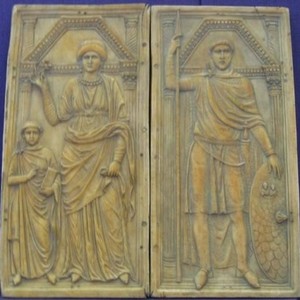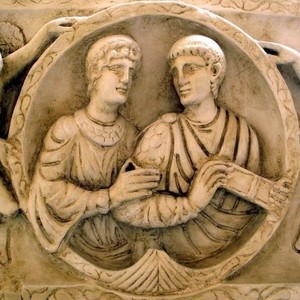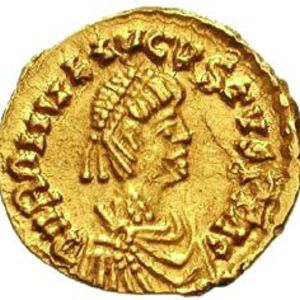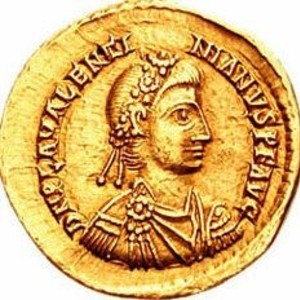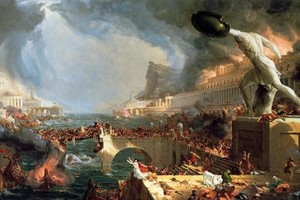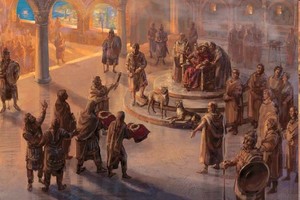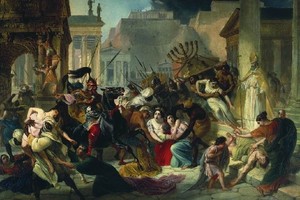Fall of the Western Roman Empire
The fall of the Western Roman Empire (the fall of the Roman Empire, the fall of Rome) was a protracted process of decline that rendered the state incapable of governing its vast territory and led to its cessation. In the year 410, Rome was captured by the Visigoths, and on September 4, 476, the leader of the Germanic tribes, Odoacer, forced the last emperor of the Western Roman Empire, Romulus Augustus, to abdicate. Thus ended Rome's centuries-long dominion.
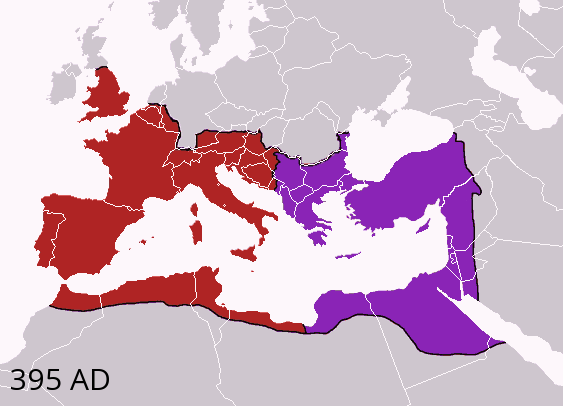 Division of the Empire among the Sons of Theodosius
Division of the Empire among the Sons of Theodosius
Background
In 395 AD, shortly before his death, Emperor Theodosius I (reigned from 347 to 395) divided the previously unified Roman Empire into two parts: the Eastern Roman Empire with its capital in Constantinople (also known as the Byzantine Empire, or, as it would be called much later, the Byzantine Empire, which lasted until 1453), and the Western Roman Empire with its capital in Mediolanum (modern-day Milan), later moved to Ravenna (from 402 AD), which lasted until 476 AD. Both parts of the empire were ruled by Theodosius I's sons - Arcadius and Honorius.
In the East, the first emperor was Flavius Arcadius Augustus (reigned from 395 to 408), and in the West, the first emperor was Flavius Honorius Augustus (395-423). The two parts of the former Roman Empire competed and fought against each other, and they also faced increasing pressure from barbarian tribes, especially in the Western part of the empire, due to the onset of the Great Migration period. The power of the emperors in the West continued to weaken after the crisis of the 3rd century.
The Great Migration period refers to the mass movement of barbarian European tribes from north to south, towards the borders of the Roman Empire. It took place from the 4th to the 7th century in Europe and resulted in the downfall of the Western Roman Empire, particularly due to the attacks of the barbarians. The beginning of the Great Migration period is considered to be the invasion of the Hunnic nomadic tribes from the east in the middle of the 4th century.
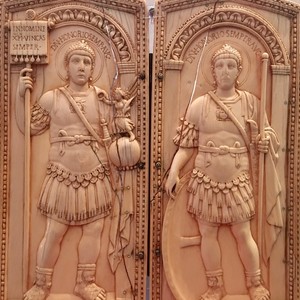 Ivory diptych of the Consul Anicius Petronius Probus with the image of the Emperor Honorius. From the Cathedral of Aosta, Italy, A detail of the Emperor and an inscription with an inscription in the nomination of Christy Winkas Semper. Aosta, Museo del Tesoro (Art Museum). Beginning of the 5th century.
Ivory diptych of the Consul Anicius Petronius Probus with the image of the Emperor Honorius. From the Cathedral of Aosta, Italy, A detail of the Emperor and an inscription with an inscription in the nomination of Christy Winkas Semper. Aosta, Museo del Tesoro (Art Museum). Beginning of the 5th century. Main events that led to the fall of the Western Roman Empire
Due to the weakening of imperial power and the increasing pressure from western barbarians within the Empire, a gradual decline in trade, economy, crafts, and cities began.
- In 401, the Visigoths led by Alaric invaded the Western Roman Empire but were defeated in 402.
- In 404, the barbarian tribes of the Ostrogoths, Vandals, and Burgundians, led by Radagaisus, once again invaded the borders of Rome. They were barely stopped by the guardian and mentor of the young emperor Honorius, the Vandal Stilicho.
- Stilicho (358-408) was of Vandal origin and had risen through the ranks as a military officer under Theodosius I. He became the de facto ruler of the Western Roman Empire during the reign of Emperor Honorius and repeatedly saved the empire from invading barbarian tribes. It was Stilicho who thwarted Alaric's first attempt to capture Rome in 408 by defeating his forces at the gates of the city. However, Stilicho was falsely accused and executed as a result of intrigues and conspiracies. After his execution, Honorius began persecuting Stilicho's barbarian supporters within the Roman service. In response, some of Stilicho's soldiers defected to Alaric's side and took part in his second campaign against Rome in 409-410. During this campaign, Rome was captured in 410 and subjected to two days of looting, while the emperor made no attempt to help the city and remained safely behind the walls of Ravenna. As a result, the Visigoths were granted territories in Aquitania (southwest modern-day France) that formally remained part of the Western Roman Empire but de facto formed the first independent barbarian kingdom within its territory.
- The usurper Constantine (407-411) seized parts of the Western Roman Empire, including Britain, Spain, and part of Gaul. In 411, he was defeated, and the unity of the Western Roman Empire was restored. However, while the struggle between the usurper and Honorius continued, the barbarians managed to breach the Germanic limes (frontier) and began ravaging Gaul and Spain.
- Under Honorius's successor, Emperor Valentinian III (425-455), the pressure from barbarians on the Western Roman Empire intensified.
- In 429, the Vandal and Alan tribes, led by Geiseric, started the conquest of the African province. They first drove out the armies of the Western Roman Empire and later defeated the Byzantine army, establishing their own kingdom that lasted until 534 when it was conquered and destroyed by Byzantium.
- In the 440s, the pressure from the Angles, Saxons, and Jutes intensified in Britain. The Romanized Britons, who were left to defend themselves after the departure of the Romans in 409, had to fend off attacks from the Saxons and Jutes on their own.
- In 451, the Huns, led by Attila, invaded the territory of the Western Roman Empire from the east. They were halted by the Roman general Aetius, along with several barbarian tribes (Visigoths, Franks, Burgundians, and Saxons), defeating the Huns in the Battle of the Catalaunian Plains in Gaul in June 451. The Huns retreated, but in 452, they invaded Italy. Only the death of Attila in 453 and the disintegration of the Hunnic confederation relieved Rome from the threat. Aetius, following Stilicho's fate, rose to power but was executed in 454 by Emperor Valentinian III due to intrigues from his enemies. Aetius was the last significant non-barbarian Roman general. His death helped Valentinian III's enemies to overthrow him in March 455, and in June 455, Rome suffered a devastating sack by the Vandals. This event introduced the words "vandal" and "vandalism" into many languages worldwide. Subsequently, the Vandals subjugated Sicily, Sardinia, and Corsica.
- In 457, the Burgundians occupied the Rhone basin, establishing the independent Kingdom of Burgundy.
- The Western Empire continued to weaken, losing territories and provinces, and the emperors became mere puppets in the hands of barbarian warlords who proclaimed and deposed emperors at will.
- The short reign of Emperor Flavius Julius Majorian (April 457 to August 461) became the last glimmer of hope for the Western Roman Empire. Majorian managed to reconquer parts of Spain and Gaul for Rome, but he was overthrown and killed in 461 by the barbarian warlord Ricimer. The decline of the
- Western Roman Empire resumed, and by the mid-460s, only Italy remained under Rome's control.
- The last glimmer of hope for the Western Roman Empire was the short-lived reign of Emperor Flavius Julius Majorian (he ruled in April 457-August 461), who was able to win back part of Spain and part of Gaul for Rome, but was overthrown and killed in 461 by the barbarian general Ricimer. The decline of the Western Roman Empire continued again, and by the mid-460s, only Italy remained under Roman rule.
The fall of the Western Roman Empire
The Western Roman Empire finally fell in 476 AD when the Germanic warlord Odoacer deposed the last Roman emperor, Romulus Augustus, and sent the symbols of his power – the purple cloak and diadem – to the Eastern Roman Emperor Zeno (who reigned from 474 to 491). Odoacer established his own barbarian kingdom on the territory of Italy.
In response to receiving the symbols of power from Italy, the Eastern Roman Emperor Zeno granted Odoacer the title of patrician and recognized him as the Roman governor of Italy, although he effectively remained an independent ruler.
In modern historical scholarship, the events of 476 AD are considered the end of the era of Antiquity and the beginning of the next historical period, the Middle Ages.
Causes of the fall of the Western Roman Empire:
1. Economic factors: Decline in agriculture, inefficient use of slave labor.
2. Political factors: Weakening of imperial power and authority.
3. External factors: Increasing pressure from barbarian tribes at the empire's borders.
4. Climate factors: Shift towards drought and cold weather.
The causes of the fall of the Western Roman Empire are still debated in scholarly circles. Barbarian kingdoms emerged on the ruins of the Western Roman Empire, and over time, many modern European states were formed. The decline continued even after the fall of the Western Roman Empire, with the Senate ceasing to exist by 630 AD.
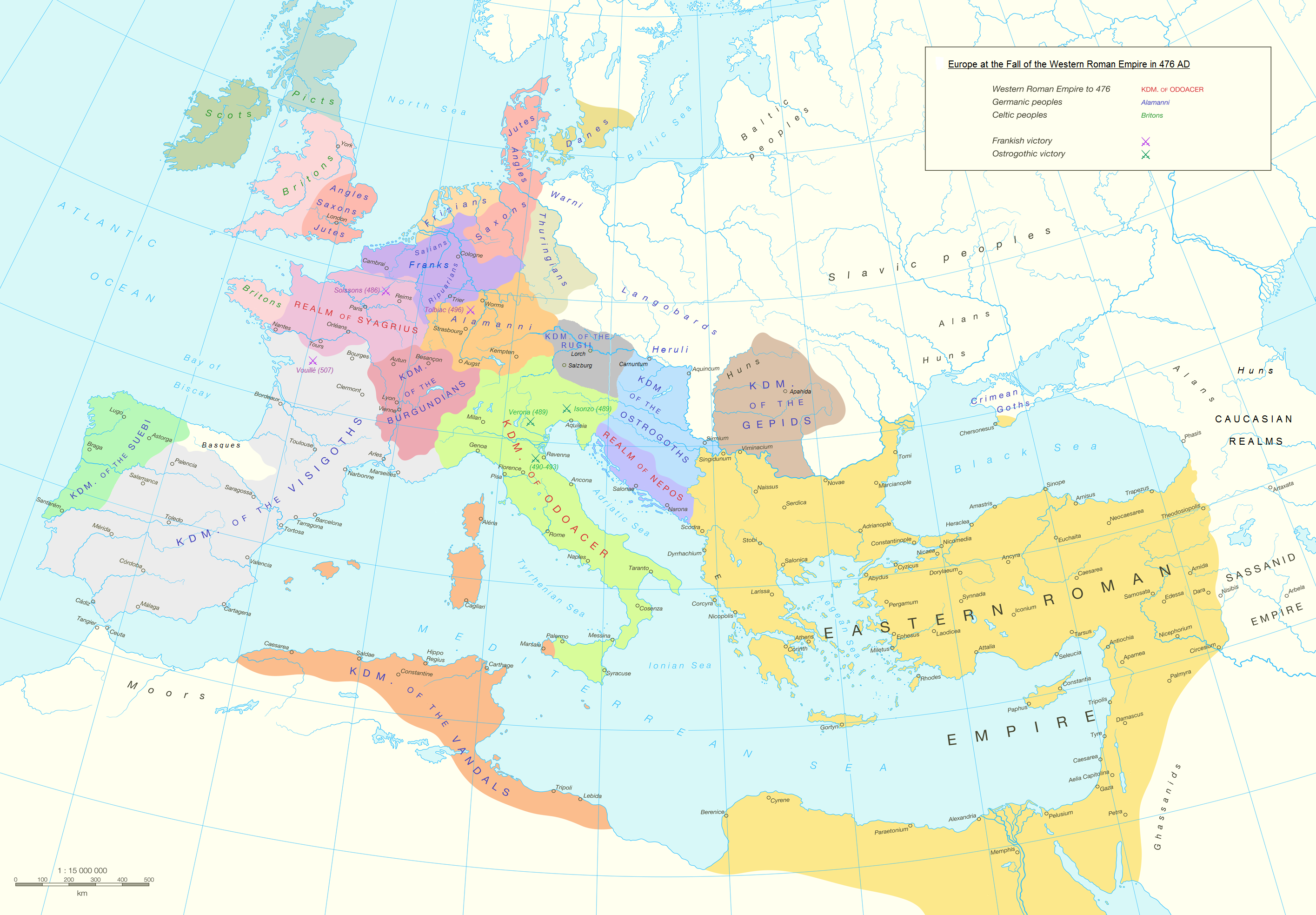 Europe and the Mediterranean in 476
Europe and the Mediterranean in 476
